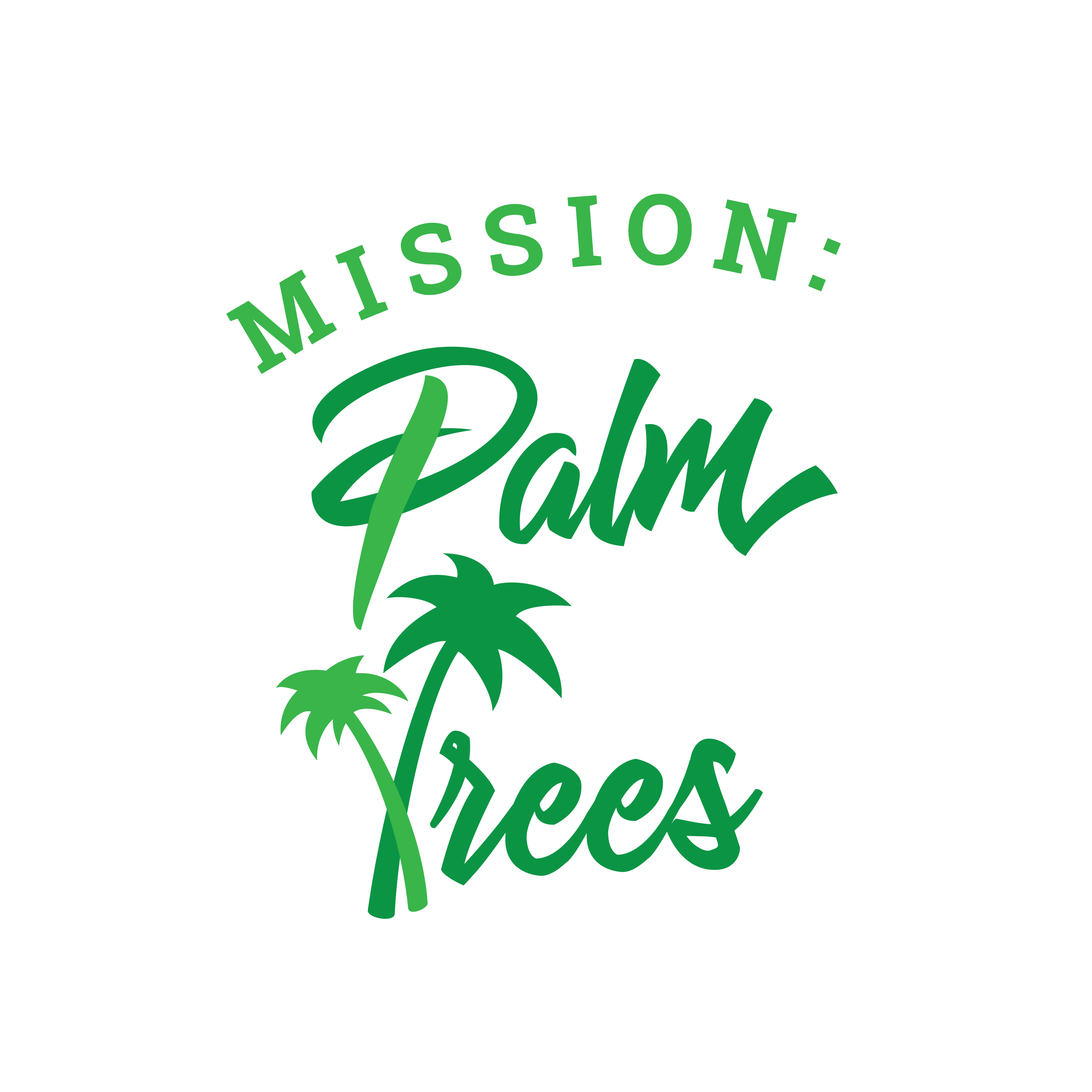- Home
- What are Palms?
- Palmy Looking Plants
Palm Tree Looking Plant
(14 That Aren’t Actually Palms)
People love palm-like plants, and palm trees.
Palms are a tropical design staple — tall, graceful, and lush. But not every plant with arching fronds and a thin trunk is a true palm.
In fact, many of the most popular plants like a palm tree aren’t palms at all!
- Did you spot a mysterious palm-like plant at a friend’s house?
- Did you want to create a tropical vibe indoors?
- Did you become curious about palm lookalikes?
So then, what is the plant that looks like a palm tree?
We’ll introduce you to 14 stunning plants that mimic the palm tree aesthetic. We'll give you their basics of care, to figure out if it could be the right plant for you.
Why So Many Plants Look Like Palms — But Aren’t
These palm-like plants come from completely different plant families than true palms.
For instance, the families Asparagaceae and Cycadaceae have palm tree looking plants. While true palms belong to the Arecaceae family.
But how is it they have similar appearances? Because of a natural process that evolved called convergent evolution. Continue on to see how that works.
Feeling overwhelmed by so many palm trees?
You're not alone. We Understand your headaches! At Mission: Palm Trees you'll find clear answers to questions & Step-By-Step Guidance, from real people. With solutions to help. No puzzling shoptalk. No tiring research. So it's easy & fun for you.
Real Palm vs. Palm-Like: What’s the Difference?
Convergent evolution is like when animals or plants from different families end up looking or acting the same, even though they're not closely related.
Imagine two people from different parts of the world who have never met, yet both look really similar. That's kind of what happens in nature!
Let's think about palm trees first.
True palm trees have certain features like tall trunks with big, flowing leaves at the top. But we see other plants that aren't really palm trees at all, but look just like them!
These palm look-alikes, like certain cycads and yuccas, have developed similar traits because they live in similar environments. So it's not because they come from the same plant family or genus.
So, palms and palm-like plants may look like brothers and sisters. But it's more like they're distant cousins who just happen to dress alike!
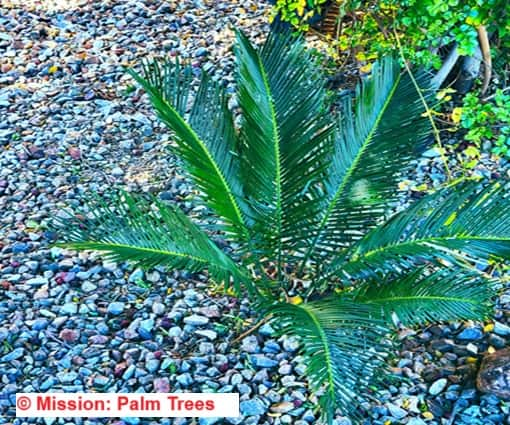 Is this a baby palm tree? No - it's a palm tree looking plant.
Is this a baby palm tree? No - it's a palm tree looking plant.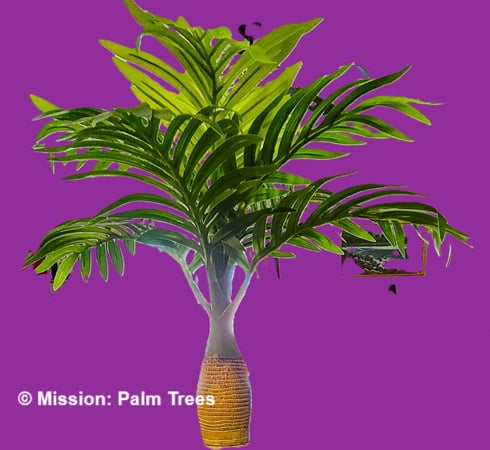 A true palm? Yes, but it's artificial!
A true palm? Yes, but it's artificial!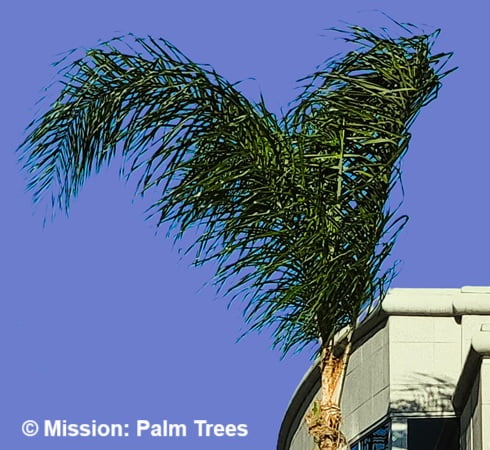 A true palm? Yes, with a bad trim!
A true palm? Yes, with a bad trim!Key Visual Features That Defines a "Palm Look"
Palm-style plants usually share traits with authentic palms, like:
- Fan-like, fern-like or feathery-shaped fronds.
- Upright and woody trunks.
- Graceful, arching growth appearance.
- A sense of height and airiness.
The Allure of the Palm Aesthetic
Palm tree looking plants also bring your senses to the tropics!
They have you thinking about Vacationing, Relaxation, and Sunny Vibes. Their dramatic leaves and upright growth habit make them popular indoor and landscape choices.
For interior designers, landscapers (even in Designs Around Your Feature Palm) and home gardeners alike.
Don't miss our ending, where you can get your own Palm Tree Looking Plant Cheat Sheet - for free.
12 Palm Tree Looking Plants to Know and Grow
Many tropical and subtropical palm tree like plants contain defensive compounds.
They're meant to keep predators away. These substances can cause irritation or illness if mishandled or ingested. But that's not the case with all of these plants! And those that do, aren't necessarily problematic.
We'll divide up our palm tree looking plants into Non-toxic and Toxic sections.
Palm Look-Alikes Containing Toxins
Several palm tree looking plants have some toxicity.
Their beauty can disguise that fact! It's a good thing to be aware of this. But there won't normally be any worries about having one of these. Unless:
- You have a pet that loves taking bites out of plants.
- You have children (no matter what age!) who like to dive into the middle of plant parts - the leaves, the flowers, the fruit. Feeling them, smelling them up close, etc.

What are the Disadvantages of Sago Palms?
One of the most convincing palm lookalikes, Cycas revoluta, is actually a cycad.
You'd think with that name, it would be in the Palm Family. Because its stiff, dark green fronds grow out from a central trunk.
The difference is palms are angiosperms, which means flowering plants. But cycads are gymnosperms. Which don't flower. Instead they produce cones that contain seeds.
Several common names are Japanese Sago Palm, King Sago Palm & Sago Palm.
- Indoor/Outdoor: Both
- Toxicity: The major disadvantage of Sago Palms are that all parts are highly toxic to pets or humans. Especially the seeds.
- The toxin is called cycasin.
- It can cause serious liver damage and more problems. See Our FAQ>
- Light: Bright indirect light to partial shade
- USDA Zones: 9-12
- Water: Keep its soil moist & well-drained
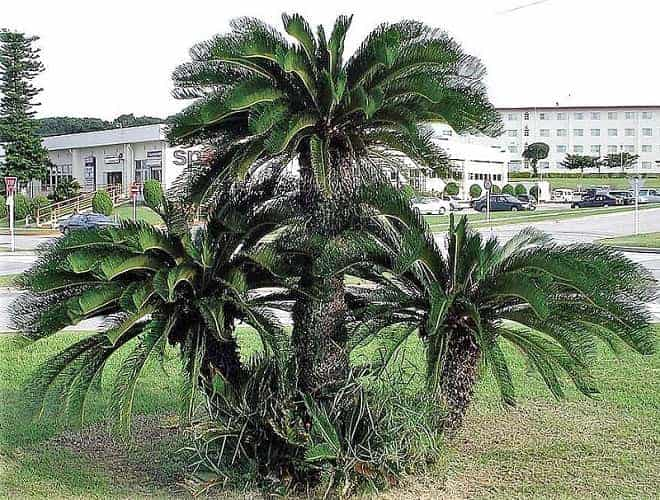 The interesting Sago Palm that's not a palm! Growing in Japan
The interesting Sago Palm that's not a palm! Growing in JapanDragon Tree - Is It a Palm?
Dracaena marginata is not a palm.
But its narrow leaves and upright stem trick many. Like palms, it is an angiosperm - a flowering plant. But it's in the Asparagaceae family.
It’s also incredibly hardy.
- Indoor/Outdoor: Maybe the ideal palm tree looking plant indoor as a houseplant.
- Toxicity: Toxic to animals and humans. It's more dangerous to animals - your pets, than it is for people.
- The chemical that causes the toxicity is called saponin.
- It can cause digestive issue along with vomiting, and uncontrolled drooling.
- Light: Bright, indirect
- USDA Zones: 10-12
- Water: Medium amount for uniformly moist soil in growing season. Less other seasons.
What About the Yucca Family?
What tree is mistaken for a palm tree?
Yuccas are probably the one. But as we've showing you here, they aren't palms.
The Tree Aloe, Aloidendron barberae, is a succulent (able to store water) yucca. It's also in the Asparagaceae family.
- Indoor/Outdoor: Best outside
- Toxicity: mild
- Contains aloin, a bitter yellow substance. Can cause skin irritation on contact, especially with sensitive individuals.
- If ingested, can cause digestive issues and diarrhea.
- More dangerous to pets than humans.
- Light: Full to partial sun
- USDA Zones: 8-24
- Water: Drought tolerant, douse monthly in growing season. None in winter.
Wondering about Aloe Vera? See Our FAQ>
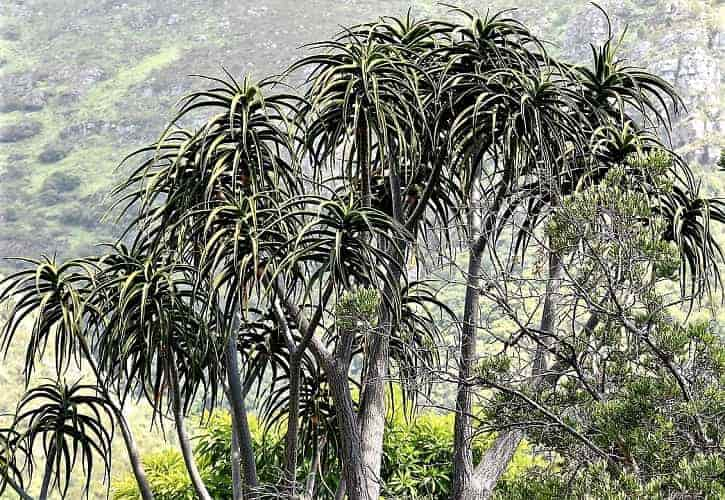 Notice the branching on these Tree Aloes. Which is extremely rare for palms.
Notice the branching on these Tree Aloes. Which is extremely rare for palms.Frequently Asked Questions
So then, does Aloe Vera have toxins?
So then, does Aloe Vera have toxins?
Note About Toxins in Aloe Vera:
Aloe vera does have a toxin. It's aloin, also called barbaloin. It's a yellow sappy latex found in the outer leaf layer, just under the skin.
- It's a powerful laxative that can be dangerous if ingested. Pets are especially sensitive to aloin.
- Can cause severe digestive issues and cramping
- Has been banned by the FDA as a laxative ingredient
Yet we all know aloe has beneficial properties. It's because:
- There's clear gel inside the leaves. That's safe when properly prepared.
- Commercial Aloe vera products are processed to remove aloin
- That process avoids the toxins, so Aloe vera benefits are available.
To make the Aloe vera safe, the outer leaf skin must be carefully removed. Then the inner gel is processed to remove and clear any residual aloin.
Can a dog survive Sago Palm poisoning?
Can a dog survive Sago Palm poisoning?
Sago Palm Poisoning is extremely serious for dogs or cats. It can be fatal.
Sago palms contain cycasin. A toxin that's highly poisonous to canines.
Even small amounts can cause severe symptoms: vomiting, diarrhea, seizures, liver failure, possibly even death. Immediate veterinary attention is essential if you suspect your pet has eaten some.
Your vet may induce vomiting, give activated charcoal for absorption & elimination, start an IV for fluids, and add liver protectants. While giving supportive care.
Yes, it's possible for a dog to survive. If its gets to the vet without delay for aggressive treatment. The dog's outcome depends on the amount consumed plus how fast treatment starts.
If you have a pet, think seriously About Growing Sago Palms. Prevention is the best solution.
Giant Palm Lilly Care Basics
The Giant Palm Lilly (Cordyline manners-suttoniae) is another example of a palm tree looking plant. It's in the Asparagaceae family.
- Indoor/Outdoor: Potted with excellent drainage - in or out.
- Toxicity: Mild
- Contains saponins, similar to other Cordyline species.
- Can cause digestive upset if ingested.
- Light: Partial to full shade
- USDA Zones: 10a
- Water: Lots of regular watering
What Giant Yucca Height is Possible?
Yucca elephantipes has several common names: spineless yucca, soft-tip yucca, blue-stem yucca, yucca cane, and itabo.
Tall (up to 30ft/9.1m - a bit shorter indoors), tough, and sculptural. A spiky palm-like plant. Excellent for minimal-care landscapes.
- Indoor/Outdoor: Both
- Toxicity: Mildly toxic from saponins. Which causes bodily irritation and digestive problems if it's swallowed.
- Light: Brightly direct or a little shade
- USDA Zones: 9-10
- Water: Medium needs, let it dry in-between. Its drought tolerant.
 Seems like a desert palm - but it's not!
Seems like a desert palm - but it's not!Umbrella Tree Scientific Name
The species Schefflera arboricola has glossy, umbrella-shaped leaves.
Those fronds arch outward, mimicking a palm canopy. Especially in tall, single-stemmed forms.
- Indoor/Outdoor: Indoor planting is preferable.
- Toxicity: Mildly Toxic From Calcium Oxalate crystals. (These crystals are also in several true palms.)
- If consumed, these crystals irritate the mouth and throat.
- Causing difficulty with swallowing.
- Light: Bright, indirect.
- USDA Zones: 10-12
- Water: Let the soil get nearly dry, then rewater deeply.
 Stems lead to multiple leaflets, appearing umbrella-shaped.
Stems lead to multiple leaflets, appearing umbrella-shaped.Giant White Bird of Paradise Indoors Can Work!
Strelitzia nicolai is also called the wild banana.
Its long, upright leaves resemble banana or palm foliage. Adds bold height and tropical flair indoors.
- Indoor/Outdoor: Both
- Toxicity: Mildly toxic, particularly its flowers and seeds. It contains two toxins: hydrocyanic acid and tannins.
- Light: Bright, direct
- USDA Zones: 9-11
- Water: Average needs
Newest Article
-
Kinds of Palm Trees Florida Climates Support
Discover kinds of palm trees Florida has around every corner. Those natives & non-natives. See the region, height, appearance, cold tolerance & more.
Nontoxic Palm Tree Lookalikes
These palm tree looking plants don't have any toxic issues.

Ponytail Palm Care Basics
The Ponytail Palm, no matter its name, is not a palm at all!
That's the common name given to Beaucarnea recurvata. Which is actually a succulent, an agave. This palm tree looking plant is quite popular.
Even though it's often grown outdoors, it can be perfect for tabletops or floor displays.
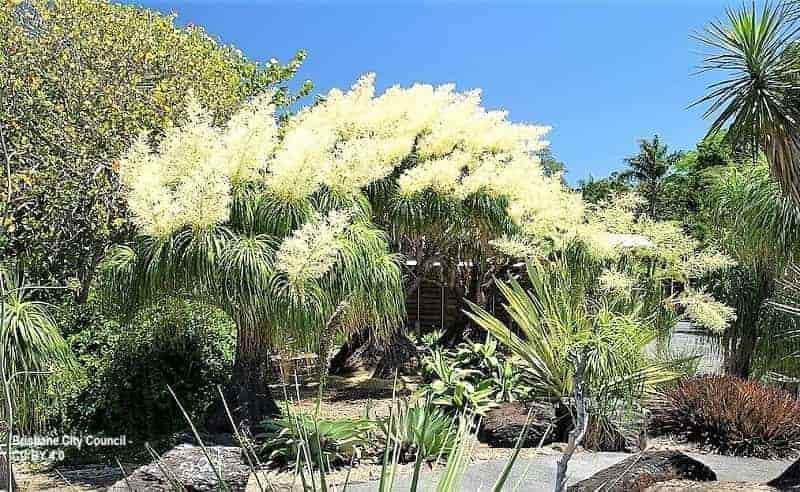 These Pony Tail Palms are in their flowering stage. Rising from the crown's top.
These Pony Tail Palms are in their flowering stage. Rising from the crown's top.With its bulbous base and long, thin fronds, this small palm-like plant resembles a mini palm tree.
- Indoor/Outdoor: Excellent indoors for colder zones, but outdoors preferable when possible.
- Toxicity: Actually non-toxic. Although some confuse it with toxic palm look-alikes. But it is safe.
- Light: Full sun, or inside near sunny windows
- USDA Zones: 9-10
- Water: Water deeply & infrequently. Overwatering is the Most Common cause of failure. As its native to semi-deserts.
New Zealand Cabbage Tree Care
A Palm Tree Looking Plant Outdoor
Cordyline australis is also known as the Cabbage tree.
Its plant family is Agavaceae. Although native to NZ, it's seen in many cooler climates outside that country.
- Indoor/Outdoor: outdoors
- Toxicity: nontoxic
- Light: Full size to some shade.
- USDA Zones: Their hardiness zone range is 7-10
- Water: Average, keeping it moist but well-drained.
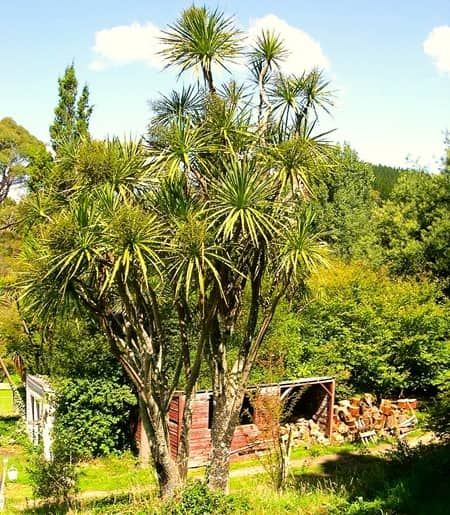 A looker growing nicely in rural New Zealand
A looker growing nicely in rural New ZealandSwiss Cheese Plant Scientific Name
Monstera deliciosa is its species name.
A very palmy looking plant, native to Mexico. It grows there in southern tropical forests.
A very popular houseplant that's commonly mistaken for a palm. It's also favored for Outdoor Landscaping Plans in the tropics.
- Indoor/Outdoor: Either Outside/Inside
- Toxicity: Nontoxic, it even has edible fruit (think of deliciosa)
- Light: Light shade
- USDA Zones: 10-12
- Water: Regularly during the growing season, lessen in winter
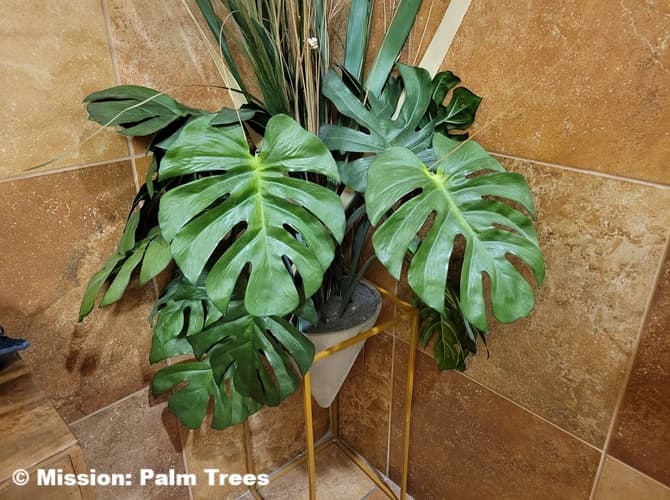 This Monstera looks quite real, but it's artificial.
This Monstera looks quite real, but it's artificial.Japanese Aralia Cold Hardiness
Fatsia Japonica is a broad-leafed beauty.
Also called figleaf palm, paperplant, false castor-oil plant, or Japanese aralia. Often grouped with palms in tropical gardens due to its dramatic foliage. But it's in the Araliaceae family.
- Indoor/Outdoor: Both
- Toxicity: Non-toxic
- Light: Partial to full shade
- USDA Zones: 7b-10b, much more cold hardy. Typically can survive low temps to 5oF/-15oC.
- Water: Occasional full wetting, drought tolerant when established.
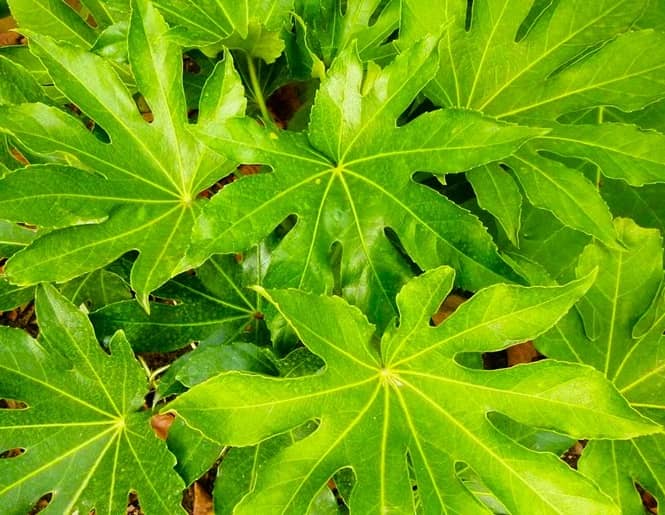 View of the crown with a close-up of the leaves.
View of the crown with a close-up of the leaves.Cast Iron Plant Physical Characteristics
Aspidistra elatior is slow-growing and very tough.
Its upright, tropical leaves make it an understated palm alternative for low-light rooms. It's an angiosperm in the family Asparagaceae. With many variants.
- Indoor/Outdoor: Indoor preferred. Outdoors spreads, like a ground-cover.
- Toxicity: None
- Light: Low light
- USDA Zones: 7-11
- Water: Regular irrigation, drought tolerant
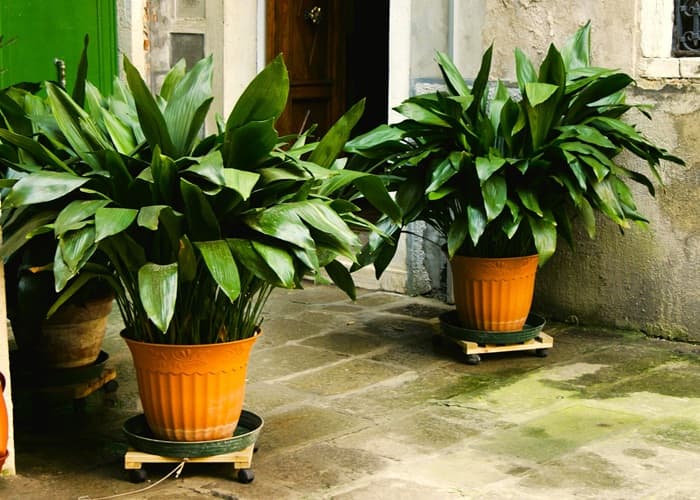 More nicknames: bar-room plant, and in Japan it's haran or baran.
More nicknames: bar-room plant, and in Japan it's haran or baran.Banana Plant - for Full Sun or Shade?
Musa acuminata offers tall, arching leaves that sway like palm fronds.
But it's not a palm. It does need space and humidity to thrive.
- Indoor/Outdoor: Outdoor or large indoor spaces with very bright sunlight
- Toxicity: Fully safe, with edible fruit
- Light: Full sun 6+ hours/day
- USDA Zones: 10a-11b
- Water: Lots of water during warm weather or while fruiting.
 Banana Plant in the Caribbean
Banana Plant in the CaribbeanTakeaways for palm tree looking plant
You've seen that many plants share the distinctive tropical appearance of palm trees without actually being true palms.
These palm tree looking plants include cycads, yuccas, dracaenas, and others. Each has unique traits along with that desirable palm-like vibe.
CLICK HERE TO DOWNLOAD YOUR FREE LOOK-ALIKES CHEAT SHEET>
Whether you're seeking indoor decorative options or outdoor landscaping alternatives, we hope we've gotten you better understanding of these palm-like plants. You might now choose the perfect one for you, with knowing the basics of proper care and maintenance.





